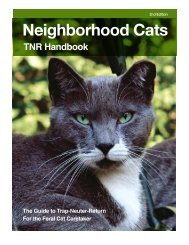Surveying roaming dog populations: guidelines ... - Animal Sheltering
Surveying roaming dog populations: guidelines ... - Animal Sheltering
Surveying roaming dog populations: guidelines ... - Animal Sheltering
You also want an ePaper? Increase the reach of your titles
YUMPU automatically turns print PDFs into web optimized ePapers that Google loves.
CONTENTS<br />
INTRODUCTION<br />
COUNTING DOGS<br />
IN PUBLIC AREAS<br />
MONITORING ONCE<br />
INTERVENTION BEGUN<br />
CONCLUSIONS<br />
Counting within a selected block<br />
The protocol used to count <strong>roaming</strong> <strong>dog</strong>s within a selected block is intended to count all the <strong>dog</strong>s that are<br />
<strong>roaming</strong> (i.e. not accompanied by an owner) on public property at the time of the count. It is impossible to<br />
make an exact count and of course the number of <strong>dog</strong>s within a block will vary during the count as <strong>dog</strong>s<br />
move in and out across the block boundaries. However it should be possible to get near to the average<br />
number within the block during the counting period by following a few simple <strong>guidelines</strong>, and experience<br />
has shown that repeated counts of a block give very consistent results.<br />
The best time to start a count is usually at dawn, before garbage is collected, and it should be completed<br />
within one or two hours, before the streets fill with traffic; this will ensure the counter sees the maximum<br />
number of <strong>roaming</strong> <strong>dog</strong>s and can move easily through the streets. This means that a single counter or<br />
counting team is unlikely to count more than one block per day. An alternative is to count at night, as was<br />
done in Cairo, where most streets are well lit and <strong>dog</strong>s are active at night.<br />
Detailed street maps of the selected blocks are required to ensure that every street is covered. If there are<br />
no accurate street maps available, satellite images may provide an alternative (e.g. Google Earth -<br />
http://earth.google.com). Otherwise it will be necessary to prepare a rough map of the block showing the<br />
street layout, which need not be to scale – this could be done at a time unsuitable for counting. Hand-held<br />
GPS receivers have been found to have limited use because of loss of signal in narrow streets and under<br />
trees (this may change as GPS technology improves), but a simple compass can be useful for orientation in<br />
areas of narrow winding streets.<br />
The method of travelling should allow you to move quickly but also allow you to search thoroughly.<br />
Walking will allow for a thorough count but is slow. Cycling and walking, pushing the bike when required, is<br />
a good compromise.<br />
When counting a block there should be an agreed protocol for including <strong>dog</strong>s at block boundaries. One<br />
suggested protocol is to include any <strong>dog</strong> that is to the inside of the centre line of the boundary road when<br />
passed by a counter. In this protocol, the counter should not try to include a <strong>dog</strong> by adjusting their speed in<br />
order to pass the <strong>dog</strong> while it is within the centre line, as this would bias the results.<br />
The counters need to move down every street, counting each <strong>dog</strong> they see (although sometimes they may<br />
be able to observe the entire length of a side street without needing to travel down it). The aim is to be as<br />
thorough as possible, searching for <strong>dog</strong>s in potential hiding places (e.g. under cars, in drains) but keeping a<br />
reasonable rate of progress. Usually the <strong>dog</strong>s are variable enough in appearance and at a low enough<br />
density for counters to avoid double-counting individuals. Keeping a reasonable speed of movement through<br />
the block will also reduce the number of times a <strong>dog</strong> is seen more than once.<br />
A few <strong>dog</strong>s may be missed as they turn a corner or move out across the block boundary ahead of the<br />
counters. However, on average, the <strong>dog</strong>s counted as they move into the block will compensate for this loss.<br />
If <strong>dog</strong>s are scared off by the counters many will be missed, hence counters should move quietly and<br />
inconspicuously. It will be necessary to record the category of the <strong>dog</strong> (e.g. sex and age) as ‘unknown’ if<br />
disturbing a <strong>dog</strong> to inspect it more closely would cause it to move away from the counters.<br />
Some blocks may contain open public areas such as parks or waste ground. It is usually possible to scan<br />
such areas effectively from a vantage point or by walking across them, otherwise adjacent strip transects<br />
can be used to cover the ground between a minimum of two counters. Two counters move parallel to each<br />
other separated by a distance that ensures any <strong>dog</strong> between them will be seen by at least one counter. The<br />
counter on the leading side of the strip counts and records every <strong>dog</strong> seen in the strip (the area between<br />
themselves and the other counter). The other counter can call out to check that the counter on the leading<br />
side has noted any <strong>dog</strong>s that may be hidden from his/her view. At the end of each strip, the counter on the<br />
leading side turns around and follows the same path back, but the other counter ‘leap-frogs’ to what<br />
becomes the leading side of the second strip. This counter then counts and records for the second strip,<br />
while the other counter marks where the other edge of the last strip lies and, again, alerts the counter on<br />
the leading side to any hidden <strong>dog</strong>s. If audible communication between the counters is difficult this can be<br />
done when one ‘leap-frogs’ past the other at the end of each strip. This process is repeated until the whole<br />
area is covered. Figure 6 shows this protocol diagrammatically.<br />
ANNEXES<br />
10








